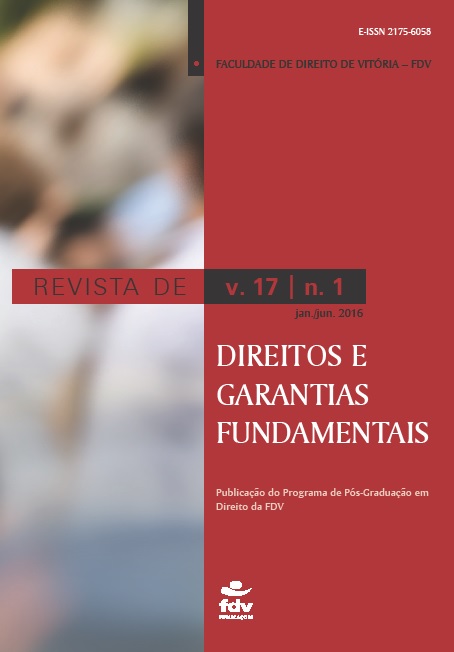A reinterpretation of the concept of contemporary alavery in the case of organ trafficking
DOI:
https://doi.org/10.18759/rdgf.v17i1.700Keywords:
Human trafficking. Organ trafficking. Contemporany slavery. Human Rights.Abstract
The Human Trafficking term (Trafficking) was internationally defined by the Palermo Protocol in the year 2000 and, despite to present an open definition,
due to the subjective elements of the crime, is configured from three constituent elements: action (objective), a (subjective) means and purpose (operating). One of the modalities relatively unknown is a Human Trafficking for pourpose of trade with organs and tissues, as it is often obfuscated between myth and urban legend. It is also understood that trafficking is a modern form of slavery, a crime against humanity, that is to ward off a person (usually vulnerable) the origin of their environment (often in a situation of socio-economic exclusion) in order to exploit it in another destination. Faced the above, the objective of this paper is to present the concept of slavery, his contemporary update and expanded interpretation of the European Court of Human Rights (ECHR) on trafficking as a contemporary form of slavery. Since then, the possibility that the trade in organs also can be considered a form of slavery arises. Therefore, the critical-theoretical reflection is sought, taking into account the legal instruments in support of the concepts discussed. The construction of this analysis has been developed under the premise that to enslave a person, it is not necessary to perform a forced activity; Thus, it is not necessary to be alive and, consequently, it is not necessary that your body is whole. The difficulty of analysis has resided in moving from the figure of “no function” to “no life”. However, this conflict has been resolved to the extent that legal science supports the primacy of personality rights, even after the death of the human body. The methodology has been articulated from the documentary, jurisprudential and doctrinal research, supported by the inductive method.
Downloads
References
ANDORNO, Roberto. ¿Todos los seres humanos son personas? Décima Sexta Jornadas Nacionales de Derecho Cilvil. Comission nº 9. Bioética y Derecho Civil, Buenos Aires, 1997.
ARISTÓTELES. Política. Lisboa: Vega, 1998, Livro I, 5, 1255.
AZEVEDO, Celia Maria Marinho de. Abolicionismo: Estados Unidos e Brasil, uma história comparada (século XIX). São Paulo: Annablume, 2003.
BALES, Kevin. La nueva esclavitud em la economía global. Madrid: Siglo XXI de España Editores, 2000.
BAUMAN, Zygmunt. Vida para consumo: a transformação das pessoas em mercadorias. tradução Carlos Alberto Medeiros. Rio de Janeiro: Jorge Zahar Ed., 2008.
BERTONCELO, Juliana Aprygio; e PEREIRA, Marcela Berlinck. Direito ao Cadáver. Trabalho publicado nos Anais do XVIII Congresso Nacional do CONPEDI, realizado em São Paulo – SP nos dias 04, 05, 06 e 07 de novembro de 2009.
COIMBRA, David. Uma história do mundo: Como se formou a primeira cidade. Como nasceu o primeiro deus único. Como foi inventada a culpa. Porto Alegre: L&PM, 2002.
CORREA DA SILVA, W. A realidade multifacetada do Tráfico de pessoas. Em: BORGES, Paulo César Corrêa. Tráfico de pessoas para exploração sexual: prostituição e trabalho sexual escravo. / Paulo César Corrêa Borges (organizador). – São Paulo: NETPDH; Cultura Acadêmica Editora, 2013. (Série “Tutela penal dos direitos humanos”), n. 3.
ESTERCI, Neide. Escravos da Desigualdade. CEDI/KOINONIA: Rio de Janeiro, 1994.
KANT, Immanuel. Fundamentação da Metafísica dos Costumes. Martin Claret: São Paulo, 2003.
ONU. OHCHR. La Abolición de la Esclavitud y sus Formas contemporáneas. HR/PUB/02/4. Naciones Unidas. Nueva York y Ginebra 2002. Disponível em: <http://www.ohchr.org/Documents/Publications/slaverysp.pdf>.
PATTERSON, Orlando. Os Elementos Constituintes da Escravidão. Escravidão e Morte Social – Um Estudo Comparativo. São Paulo: Edusp Editora, 2009.
SANCHEZ RUBIO, David. Encantos y Desencantos de los Derechos Humanos. Barcelona: Editorial Icaria. 2011.
SANDEL, Michael J. Lo que el dinero no puede comprar. Los limites Morales Del mercado. Trad. Joaquin Chamorro Mielke. 2ª edición, Barcelona: Debate, 2014.
SANDEL, Michael J. Justicia. ¿Hacemos lo que debemos? Trad. Juan Pedro Campos Goméz. Barcelona: Debate, 2010.
XAVIER, Elton Dias. A Bioética e o conceito de pessoa: a re-significação jurídica do ser enquanto pessoa. Revista Bioética, Brasília, v.8, n.2, nov. 2009. Disponível em: http://revistabioetica.cfm.org.br/index.php/revista_bioetica/article/view/277/276. último em: 01/12/2014.
Downloads
Published
How to Cite
Issue
Section
License
Proposta de Aviso de Direito Autoral Creative Commons
1. Proposta de Política para Periódicos de Acesso Livre
Autores que publicam nesta revista concordam com os seguintes termos:
- Autores mantém os direitos autorais e concedem à Revista de Direitos e Garantias Fundamentais o direito de primeira publicação, com o trabalho simultaneamente licenciado sob a Creative Commons Attribution License que permitindo o compartilhamento do trabalho com reconhecimento da autoria do trabalho e publicação inicial nesta revista.
- Autores têm autorização para assumir contratos adicionais separadamente, para distribuição não-exclusiva da versão do trabalho publicada nesta revista (ex.: publicar em repositório institucional ou como capítulo de livro), com reconhecimento de autoria e publicação inicial nesta revista.
- Autores têm permissão e são estimulados a publicar e distribuir seu trabalho online (ex.: em repositórios institucionais ou na sua página pessoal) a qualquer ponto antes ou durante o processo editorial, já que isso pode gerar alterações produtivas, bem como aumentar o impacto e a citação do trabalho publicado (Veja O Efeito do Acesso Livre).


